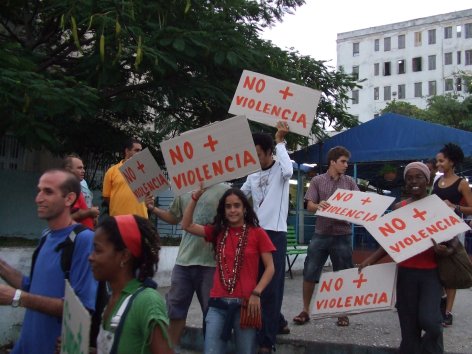A Small Battle of Ideas Against Violence (I)
Dmitri Prieto

Violence is a reality present in almost all social settings: the family, gender relationships, childhood and education, sports, wars, the State and international politics, ecology… It would be simpler but more difficult to specify situations where there is not violence. Regrettably, Cuba is not an exception to this logic.
To struggle against violence it’s necessary to develop courage, perseverance, decisiveness and a spirit of humility. There exist many theories and practices related to non-violence that propose guidelines for action and social coexistence.
As a friend wrote recently in Havana Times: “The issue of violence is indeed complex… We need to first journey to our inner soul to then take to marching in the streets.”
Last Friday something highly unusual happened in Havana. Seemingly without any call from “officials” or the “opposition,” people met on a downtown Havana street corner to then marched several blocks together in a pilgrimage against violence.
Today I consider it a privilege to have been there. But this was not the first time an event occurred in Havana dedicated to non-violence. More than a month ago, some 50 people gathered at a Vedado Cultural Center to discuss the issue and to appreciate art that questions violence. The Ahimsa Project and the Critical Observatory network organized and promoted the activity. I was glad that many of the people who attended on that occasion also participated in the march this past Friday.
At 5:00 on Friday afternoon, at the corner of G and 23rd streets, some 200 people congregated. We proceeded to walk five blocks along 23rd and then returned to the point of origin. It was not clear who organized the “performance”; seemingly, neither the official nor alternative media were used to publicize the action; the news had traveled by word of mouth.
I became involved in it because I wanted to. Just like everyone else I had an option: to be or not to be, to go or not to go. Such an option does not hold for many public actions that we know of.
In any case, 23rd and G is a well trafficked place, especially by youth, so there was nothing unusual about someone being there. I believe that most of those who went there shared that thought. Maybe they went out of interest, or for curiosity, but they were certainly clear that it required a certain degree of courage, decisiveness and commitment to be there, since something outside the norm was brewing; and like I said, we’re not accustomed to actions of that type in Cuba.
But there was always the alternative of “not going.” That was “optional” for almost everyone. But, to be truthful, some people could not come due to police interventions, which ran contrary to the tacit approval of the spirit of the pilgrimage -constantly under suspicion- by the authorities.
Their absence became a hit theme in the international media, though the coverage was not balanced.
At the same time, the pilgrimage took place regardless of the absence of a few people (of the right? Of the left?) that some wanted to present as “leaders.”
This demonstrates the limited role of “mobilization” or “manipulation,” so present in the imagery to which we’re accustomed- in people’s decision to participate in the action. We were there to participate in a singular action, not to trail behind a bunch of “leaders.”

Comments are closed.